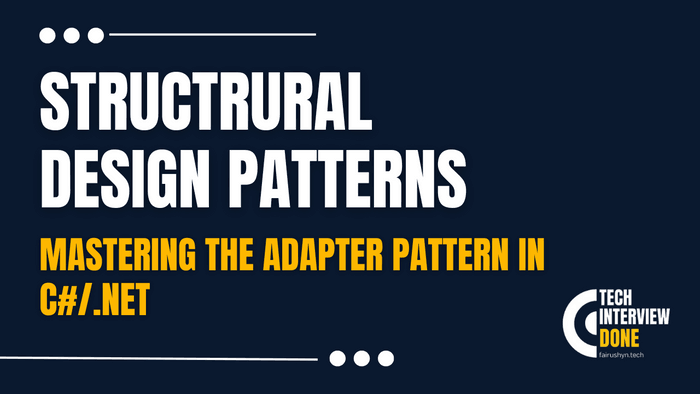Mastering the Adapter Pattern in C#/.NET
A Guide for Experienced Software Engineers
3 min read · — #design-patterns#structrural-patterns#adapter
Introduction
Imagine you're an accomplished architect tasked with integrating a stunning, century-old building into a modern, high-tech cityscape. Your goal is to preserve the building's historical essence while ensuring it functions seamlessly within the contemporary urban fabric. This scenario mirrors the challenge software engineers often face: integrating disparate systems in a way that leverages their unique strengths without compromising on functionality or design integrity. Enter the Adapter pattern, a structural design pattern that enables incompatible interfaces to communicate and work together harmoniously. This post is crafted for software engineers with a rich tapestry of experience, who understand that the beauty of software design lies in its adaptability and interoperability. We will dive deep into the Adapter pattern, exploring its nuances with examples in C#/.NET, and demonstrate its practical applications in real-world scenarios, making it an indispensable tool in your software design arsenal.
The Adapter Pattern Explained
At its core, the Adapter pattern is about making two incompatible interfaces compatible without changing their existing code. This pattern acts as a bridge, enabling objects with incompatible interfaces to communicate and operate together. It’s akin to having a universal power adapter during international travel; it allows your electronic devices to work seamlessly with different electrical outlet standards without requiring any modifications to the devices themselves.
Real-World Scenarios
-
Legacy System Integration: Imagine integrating a legacy library in a modern application. The legacy library uses outdated data formats or communication protocols. An adapter can translate the application’s modern requests into a format understood by the legacy system.
-
Third-Party Library Integration: When incorporating a third-party library that doesn’t match your application’s interface expectations, an adapter can reconcile these differences, allowing you to leverage the library’s functionality seamlessly within your application.
Implementing the Adapter Pattern in C#/.NET
Scenario: Integrating a Modern Payment Gateway into an Old E-commerce System
Suppose you're working on an e-commerce system that uses an old payment processing class. However, you want to integrate
a modern payment gateway with a different interface. The old system expects a IPaymentProcessor interface, while the
new payment gateway provides a NewPaymentGateway class with a different method signature.
Step 1: Define the Target Interface
This is the interface your application expects to work with.
public interface IPaymentProcessor
{
bool ProcessPayment(string creditCardNumber, decimal amount);
}Step 2: Implement the Adapter
The adapter implements the target interface and translates its method calls to the adaptee.
public class PaymentGatewayAdapter : IPaymentProcessor
{
private readonly NewPaymentGateway _newPaymentGateway;
public PaymentGatewayAdapter(NewPaymentGateway newPaymentGateway)
{
_newPaymentGateway = newPaymentGateway;
}
public bool ProcessPayment(string creditCardNumber, decimal amount)
{
var paymentRequest = new PaymentRequest
{
CardNumber = creditCardNumber,
Amount = amount
};
var result = _newPaymentGateway.MakePayment(paymentRequest);
return result.IsSuccess;
}
}Step 3: Use the Adapter
With the adapter in place, your e-commerce system can now use the new payment gateway as if it was the original payment processor.
var newPaymentGateway = new NewPaymentGateway();
var adapter = new PaymentGatewayAdapter(newPaymentGateway);
bool result = adapter.ProcessPayment("1234567890123456", 100.00m);Benefits and Considerations
- Interoperability: The Adapter pattern allows your application to leverage existing or third-party libraries and systems without modification, promoting reuse and flexibility.
- Simplified Interface: It can provide a simplified interface to complex systems, making them easier to interact with and integrate.
- Decoupling: The pattern helps decouple the client from the implementation of an interface, making your application more modular and easier to adapt or extend.
However, it's important to use the Adapter pattern judiciously. Overuse can lead to a system that's hard to understand and maintain, as it introduces additional layers of abstraction. It's most effective when genuinely needed to integrate components that cannot be modified to be directly compatible.
Conclusion
The Adapter pattern is a powerful tool for experienced software engineers, enabling the integration of disparate systems in a clean, maintainable way. By understanding and applying this pattern, you can create software architectures that are robust, flexible, and open to evolution, much like integrating a timeless building into a modern cityscape. As you continue to encounter and solve integration challenges in your work, remember that the Adapter pattern can be your bridge to harmonious system interoperability.
